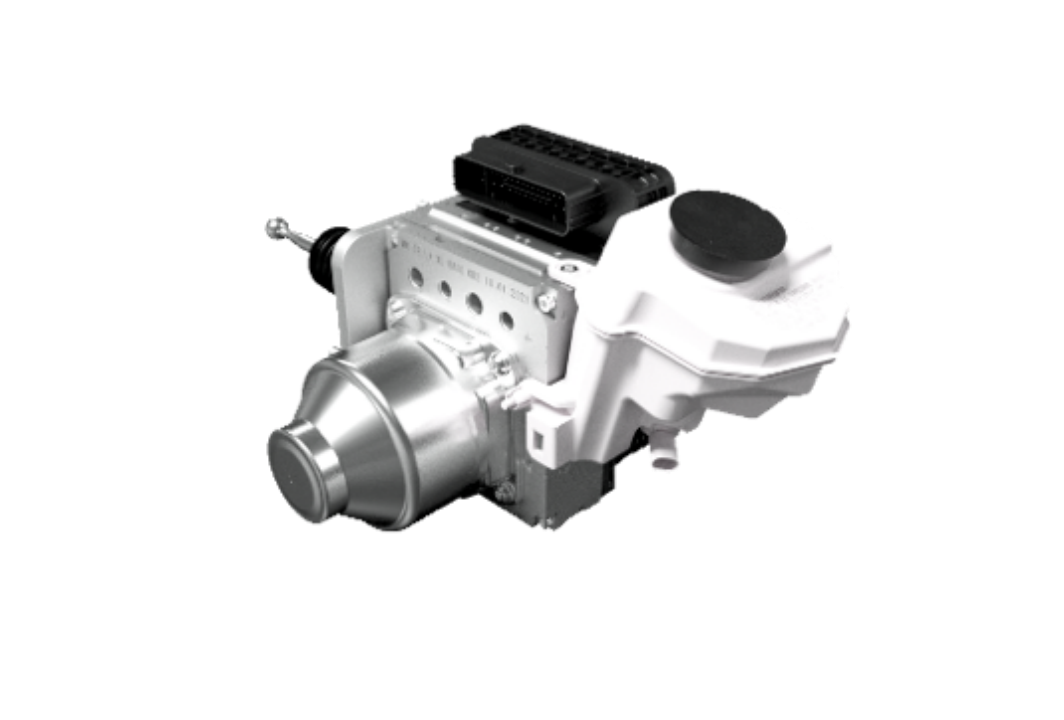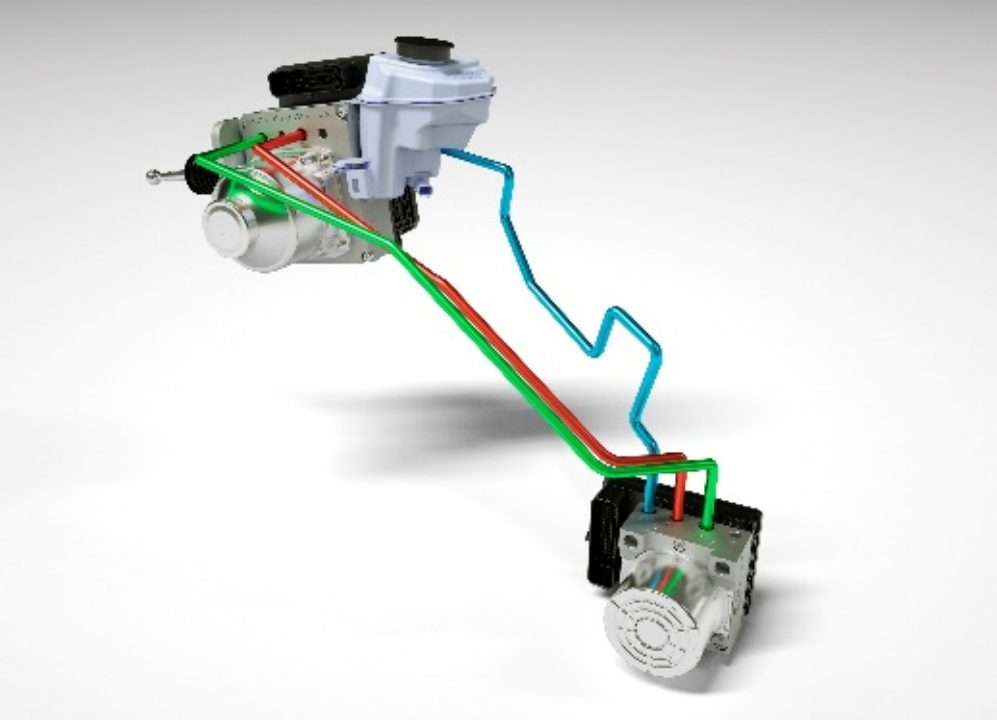With the rapid development and iteration innovation of the current automotive market towards electrification, automation, and intelligence, the braking system as an essential guarantee for safe driving is also upgrading and developing its own technology.
As the intelligent autonomous driving function continues to develop, the requirements for braking safety have also become more stringent. On March 1st, the national standard “Automobile Driving Automation Grading” (GB/T 40429-2021) was officially implemented, which has clearly defined standards and directions for the healthy development of China’s autonomous driving industry.
Continental Group has launched the MK Cx HAD line control redundant braking solution composed of the MK Cx integrated line control braking system and HBE module. Currently, this solution has been put into mass production and carried by the new model of the Arctic Wolf Alpha S·HI.
MK Cx Integrated Line Control Braking System
The integration of the Continental Group’s MK Cx integrated line control braking system and HBE module simplifies the installation of highly automated redundant braking systems and has technical advantages in lighter and faster line control braking, adapting to the development of new energy vehicles and meeting the braking safety requirements for future highly autonomous driving.
Compact
The MK Cx integrated line control braking system integrates the pedal simulator, brake master cylinder, booster, and hydraulic adjustment control system (ABS, ESC) into a compact and small braking module, reducing its weight by about 30%. It can meet the needs of new energy vehicles for lightweight and space optimization.
Thanks to its unique decoupling pedal simulator design, the MK Cx integrated line control braking system can also meet the technical requirements for different types and levels of vehicles, providing more diverse and comfortable pedal feeling.
Fast Response, Strong Recovery Ability
The MK Cx integrated line control braking system has passed the German TÜV test certification. The MK Cx integrated line control braking system under the WLTP standard can generate high enough braking pressure in just 150 milliseconds, three times faster than traditional hydraulic braking systems.
In addition, the MK Cx integrated line control braking system can shorten the braking distance in a shorter time and achieve 100% energy recovery. It can recover an average of 160 watt-hours (Wh) of electricity, which is about 32% higher than the benchmark system’s energy recovery efficiency, equivalent to increasing the cruising range of a pure electric vehicle with a cruising range of 500 kilometers by about 20 kilometers.
The MK Cx integrated line control braking system can reduce carbon dioxide emissions by about 5 grams per kilometer and fuel consumption by about 0.24 liters per hundred kilometers.
Safety
In response to the braking safety requirements in highly autonomous driving scenes, the MK Cx HAD line control redundant braking solution has a redundant downgrade backup function, which can effectively respond to even extremely low probability of failure situations.One scenario is when the main braking system fails completely, the HBE module will implement braking on the vehicle through the two front wheels, acting as a brake antilock system.
Another scenario is when only some modules in the main braking system fail, the MK Cx line control braking system will activate the collaborative braking mode independently developed by Continental Group, allowing the HBE module to join in the collaborative work to drive the rear brake system to keep working.
This innovative collaborative mode ensures that even if a system component fails during autonomous driving, the braking function can still work normally by controlling the slip ratio on both axles for deceleration through flexible separation of functions.
Continuously Iterating, MK C2 Becomes More Powerful

On November 16, 2021, technology company Continental Group completed the upgrade development of the electric-hydraulic brake system MK C1.
Continental stated that the availability and performance of MK C2 are stronger and better, and it is also more compact, lighter, and easier to integrate into smaller vehicle models and complete vehicle platforms with various power systems and installation locations. The application matching work for different vehicle models has also been simplified. In addition, the number of sub-components has been successfully reduced, thereby reducing the cost of MK C2.
MK C2 adopts a multi-logic architecture with two independent partitions, which can achieve redundancy backup mode. This improves the system’s availability, which is particularly important for autonomous driving. In addition, even the basic version of MK C2 supports highly automated autonomous parking function.
Like MK C1, MK C2 is also a “line control brake” system. The braking pedal and the pressure building process are completely decoupled. Its advantages are becoming increasingly important: in more than 80% of deceleration conditions for electric vehicles, normal driving situations can generate regenerative braking to charge the electric vehicle. However, regardless of whether the wheel brake actuator actually starts, the driver’s feeling when stepping on the brake pedal is the same.
On the other hand, during autonomous driving, when the autonomous driving or driver assistance system requires pressure, MK C2 can generate braking pressure within a short 150 milliseconds. Continental states that MK C2 is designed specifically for SAE Level 3 or higher autonomous driving.
High Dynamics and High Comfort

In electric vehicles, MKC2 seamlessly integrates energy recovery and wheel braking, which can improve the energy recovery efficiency of hybrid braking systems with traditional pedals by 30\%.# Translation in English
MK C2 achieves significant integration advantages by completely decoupling the brake pedal from the pressurization process in non-backup mode: there is no need to install the brake system directly in a specific location on the partition due to the mechanical backup mode requirement. Conversely, the MK C2 with the electric pedal supports new vehicle concepts with innovative interior designs and cabin dimensions.
MK C2 adopts a modular design with good scalability. In addition, with its intelligent modular design, the development workload required for MK C2 to adapt to various vehicle segment markets and model types has been greatly reduced. Multiple system performance levels can realize different standardized functional combinations.
New design of brake system architecture

MK C2 can be paired with mechanical pedals (= supports hydraulic backup mode) or electric pedals (= supports no hydraulic backup mode, i.e. MK C2 EP version). If the vehicle is equipped with the MK C2 EP version, when the driver steps on the decoupled electronic brake pedal, the sensor detects the driver’s braking force demand. Subsequently, the system’s motor generates hydraulic pressure.
Due to the adoption of multi-logic structures and redundant backup modes, even if a failure occurs, the vehicle’s various functions can still be used normally, providing continuous support to the driver. More importantly, even if the mechanical transmission lock is eliminated, the parking brake can still be redundantly controlled to ensure the vehicle’s safe parking.
Media and fan Q&A:
Q1: How to avoid problems of no response when braking?
For identifying the driver’s braking intent, MK Cx mainly relies on the integrated pedal travel sensors with functional safety level ASIL D to collect the driving braking actions or intentions. The sensor itself adopts a redundant design scheme, including two travel sensors that can mutually verify and check each other, and there is also a backup brake pressure sensor to assist in identifying the driver’s braking actions. Thus, even if a single sensor has a problem, it can ensure that the driver’s braking actions are correctly identified and transmitted to the executing unit.
For executing the driver’s braking intent, before each vehicle start-up, the MK Cx system will do self-check to ensure that all components of the line control system are normal, to ensure that there are no safety risks before driving.
And during vehicle motion, MK Cx will also continue to monitor whether the driver’s braking is correctly executed by monitoring indicators such as the difference between the target braking pressure corresponding to the braking stroke and the actual pressure, and the vehicle deceleration. Such monitoring can fully cover the fault detection of various parts of MK Cx itself and part of the brake system faults, such as common brake fluid leakage, brake fluid loss, and excessive air content in the brake fluid that affect brake safety.
Q2: How to adjust braking force to improve driving comfort?Thanks to the decoupled system design, the driver’s braking intention is transformed into the vehicle’s deceleration request by software algorithms.
With the calibration of software, the final deceleration of the vehicle can be achieved with the same pedal stroke or pedal force, greatly reducing hardware debugging work and shortening the debugging cycle. In addition, multiple braking modes can be integrated, and the pedal feel of MK Cx can be adjusted in real-time according to the driver’s choice or braking situation to meet the braking needs of different scenarios while ensuring safety and giving consumers a sense of participation.
Q 3: How to avoid motion sickness when driving an electric vehicle and releasing the accelerator pedal?
The decoupled structure of MK Cx means that there are no restrictions on energy recovery. It can achieve full braking in the range of 0-1 g, including energy recovery at any speed segment up to below 10 kph.
Whether using electric or hydraulic braking to recover energy, the optimal choice is made entirely by software. The transition from electric to hydraulic braking is smoother, and consumers can hardly feel it, according to Continental.
If you feel dizzy when driving an electric car, you can choose a light level of coasting energy recovery and achieve deceleration through active braking by the driver. This method can also achieve energy recovery.
Q 4: How to ensure safety in high-level autonomous driving?
For L3 and above functions at high speeds, control is handed over to the system. As speed increases, safety risks greatly increase. In the event of primary brake failure, the system still needs to be able to brake and maintain the necessary stability of the vehicle, which requires the addition of a backup braking system to meet the need.
MK Cx HAD (Highly Automated Drive) is a redundant braking system developed for advanced autonomous driving. It consists of a wire-controlled MK Cx main brake and a completely independent HBE brake unit. The MK Cx HAD system can meet the high-level autonomous driving requirements of L3-5.
Q 5: Dr. Liu, does the Continental MK Cx series support acceleration and deceleration through the intelligent driving control interface?
For the intelligent driving system, the virtual driver needs to send a virtual command to the MK Cx system representing available instructions. The instructions can take many forms, such as the common form of deceleration or the form of how many meters I want the braking system to bring the vehicle to a stop or how much deceleration is needed to stop.
Similarly, moving further up, distance and speed control can be achieved through torque interfaces. The current general approach is for the upper layer ADAS system to send a torque signal to the MKCx braking system, with ADAS doing most of the work.
If acceleration and deceleration control is used, this part is equivalent to the deceleration closed-loop function, which is moved to MKCx. For MK Cx, it can support different forms of control interfaces and adapt well to different ADAS products and suppliers.> Q6: Has Continental Group considered using wire harnesses directly to control the actuator brakes, replacing the hydraulic system?
The fact that the braking system has been based on hydraulics for so many years attests to its safety. In the future, if the hydraulic circuit is to be cancelled, it would refer to the dry brake system that has been mentioned before.
The dry brake actuator is placed directly at the wheel end and the transmission path is similar to an electrical signal sent directly to the wheel end actuator. Of course, this is feasible. Considering the current regulations or technological maturity, it may gradually replace the traditional hydraulic system in the next 5 to 10 years and use the actuator to directly control wheel deceleration.
Q7: Could MK CX support regenerative braking up to 1 g, and how is functional safety taken into account in actual engineering applications?
MK CX adopts a decoupling system, and from a structural and theoretical perspective, it fully supports energy recovery across the entire braking and velocity range, but does the capability have the opportunity to be utilized to its full capacity? This is a system concept.
The primary objective of braking is to ensure that it stops, but the electric motor is not yet at the level of perfection required. For example, it can already achieve a level of 0.3 g. Considering safety, the safety of hydraulic braking and electric braking are not yet on the same level.
At the moment, the mainstream level is generally around 0.3 g. If further improvements are to be made, such as around 0.3-0.6 g, the motor torque signal or execution needs to reach ASILC or even ASIL D level. The current electric power control system may not be able to reach such level yet. Moreover, regenerative braking is influenced by many factors, and electric motor braking alone can only serve as auxiliary or backup braking, and cannot replace conventional friction brakes.
About Continental Group
Continental was founded in 1871 to provide safe, efficient, intelligent, and affordable solutions for the automotive, machinery equipment, transportation, and logistics sectors. The Continental Group achieved a sales revenue of 33.8 billion euros in 2021. The Group currently has over 190,000 employees worldwide and operates in 58 countries and regions.
Since officially entering the Chinese market in 1994, Continental has served major auto manufacturers in various automotive sub-markets. Simultaneously, Continental also develops and produces materials, functional components, parts, and systems, which are widely used in rail transportation, machinery, engineering, mining, and other important industrial sectors.
Currently, Continental has 25 production bases and 28 R&D centers in China, with a total of about 16,500 employees, providing customized solutions for the Chinese market.
This article is a translation by ChatGPT of a Chinese report from 42HOW. If you have any questions about it, please email bd@42how.com.
